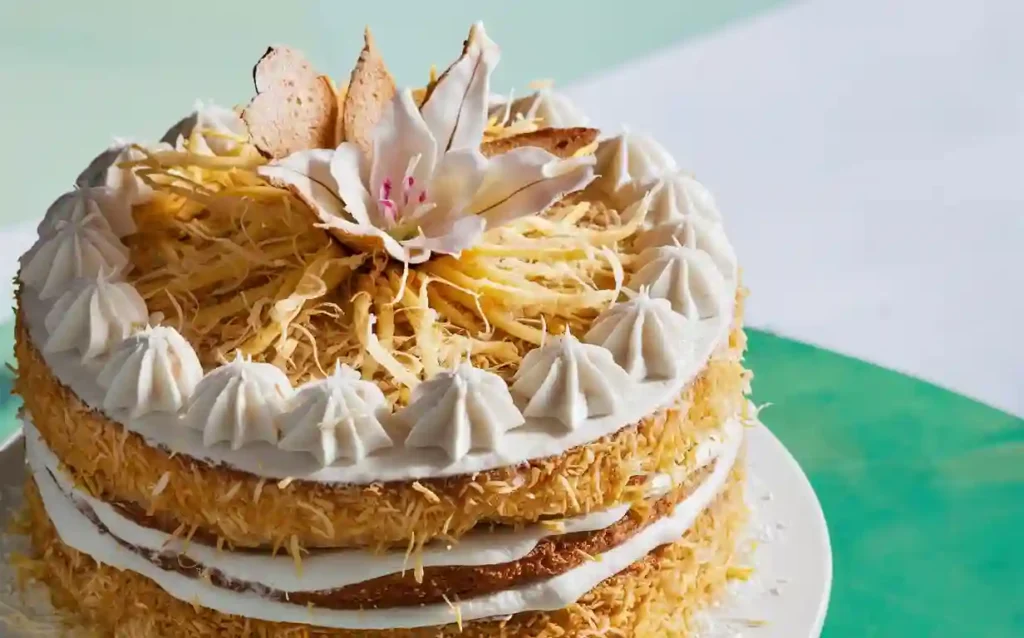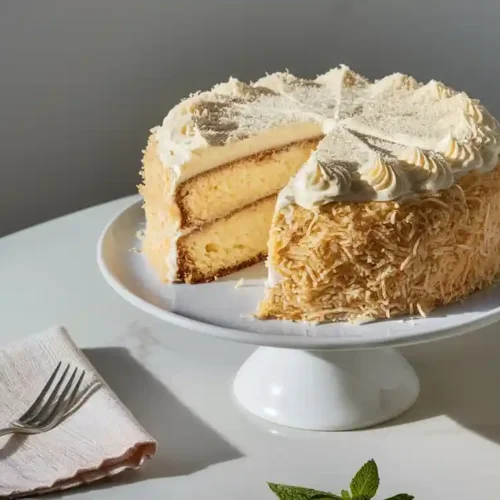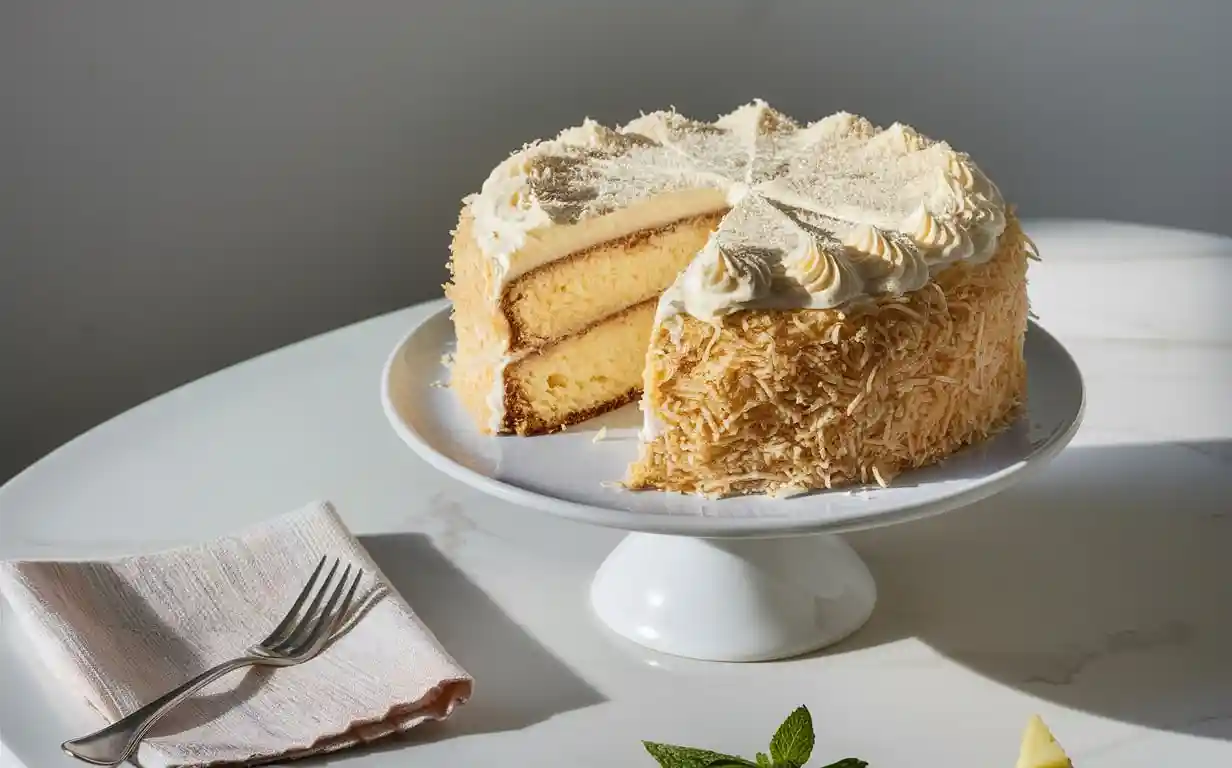Last Updated on June 2, 2025 by Lucas
Craving something sweet, fluffy, and full of tropical charm? This moist coconut cake comes together in just 50 minutes, making it perfect for busy days or last-minute gatherings. With its rich coconut flavor, creamy frosting, and light, buttery texture, it’s the kind of dessert you’ll come back to again and again. Whether you’re baking for a celebration or just because, this quick coconut cake brings a slice of island joy right to your kitchen.
Key Benefits of This Coconut Cake Recipe
Quick and Easy—Ready in Just 50 Minutes
If you’re looking for a coconut cake that doesn’t demand hours in the kitchen, this one is for you. The prep takes just minutes, thanks to a straightforward one-bowl method that simplifies cleanup and saves time. You’ll whisk, pour, and bake—all within 50 fast minutes.
- Ideal for busy home bakers: Whether you’re juggling work, errands, or kids, you can still create something spectacular.
- Minimal equipment needed: One large mixing bowl and a few basics are all it takes.
- Quick baking time: The cake bakes in about 30–35 minutes, leaving time for cooling and frosting.
This makes it an ideal choice when you’re short on time but still want to impress.
Moist and Fluffy Texture
Nobody likes a dry cake. The beauty of this coconut cake lies in its tender, cloud-like crumb—achieved by balancing moisture-rich ingredients with precision.
- Coconut milk: It adds creamy depth and natural moisture, enhancing both texture and flavor.
- Buttermilk or sour cream: These ingredients boost softness and create that soft, melt-in-your-mouth texture.
- Proper mixing technique: By gently folding the ingredients, you avoid overworking the batter, which keeps the crumb light.
If you’re after a cake that feels indulgent without being heavy, this checks all the boxes.
Bursting with Coconut Flavor
What sets this recipe apart from average cakes is its layered, multidimensional coconut flavor. You’ll taste coconut in every bite—from the batter to the frosting.
- Shredded coconut: It offers a soft, chewy texture that complements the fluffiness of the cake.
- Coconut cream in frosting: Thick and aromatic, it gives your frosting a rich tropical punch.
- Hint of vanilla extract: This rounds out the flavors and adds a bakery-style warmth.
It’s not just a cake with coconut—it’s a true coconut cake, inside and out.
Crowd-Pleaser for Any Occasion
Looking for a dessert that makes everyone pause between bites? This coconut cake fits seamlessly into any event, from casual dinners to celebratory gatherings.
- Perfect for holidays: It brings a refreshing twist to traditional dessert tables.
- Ideal for birthdays or baby showers: Light, flavorful, and not overly sweet—so guests keep coming back for seconds.
- Complements tropical meals: Serve it after grilled chicken, rice dishes, or fruit salads to complete the vibe.
Its versatility ensures it becomes one of those “go-to” recipes you’ll rely on again and again.
In summary, this coconut cake is more than a quick fix. It’s a flavorful, foolproof dessert that delivers maximum satisfaction with minimal effort. From weeknight treats to weekend celebrations, it’s ready to rise to any occasion—moist, fluffy, and unmistakably coconut.
Ingredients You’ll Need for the Perfect Coconut Cake
Whether you’re baking for a special occasion or a cozy weekend treat, using the right ingredients is key to getting a moist, flavorful coconut cake. Below, you’ll find a clear breakdown of what you need, why it matters, and how each ingredient plays a role in building flavor and texture. Stick to quality ingredients, and you’ll taste the difference in every bite.
Dry Ingredients
Your dry mix lays the foundation. It shapes the cake’s structure while letting the coconut flavor shine through.
| Ingredient | Purpose |
| All-purpose flour | Gives the cake its structure and soft crumb |
| Baking powder | Adds lightness and helps the cake rise evenly |
| Granulated sugar | Sweetens and adds moisture as it melts during baking |
Tip: Sift your dry ingredients together before adding them to the wet mixture. This step prevents lumps and ensures even distribution.

Wet Ingredients
The real magic of this coconut cake lies in its rich, moist interior. These wet ingredients bring the flavor and keep every bite tender.
| Ingredient | Purpose |
| Coconut milk | Infuses the cake with deep coconut flavor |
| Eggs | Bind the ingredients and add richness |
| Unsalted butter | Adds moisture and buttery depth |
| Vanilla extract | Balances the coconut with warm undertones |
| Buttermilk or sour cream | Adds tang and helps keep the crumb incredibly moist |
Note: Room temperature eggs and butter blend more smoothly and give your cake a consistent texture.
For the Frosting
A great coconut cake isn’t complete without a creamy, tropical-inspired frosting. This blend keeps things lush and not overly sweet.
| Ingredient | Purpose |
| Cream cheese or butter | Creates a smooth, rich base for your frosting |
| Powdered sugar | Sweetens while maintaining a fluffy texture |
| Coconut cream | Enhances the coconut profile with silky richness |
| Shredded coconut | Adds texture and visual appeal on top |
Pro Tip: Toast your shredded coconut for added crunch and a golden finish that looks bakery-perfect.
Tools and Equipment
Having the right tools at your fingertips can make your coconut cake experience smoother and more enjoyable.
| Tool | Why You Need It |
| Stand or hand mixer | Ensures a smooth, lump-free batter |
| Mixing bowls | Keeps your ingredients organized and your workspace tidy |
| 9-inch cake pans | Provides even baking and the right height |
| Cooling racks | Prevents soggy bottoms by allowing airflow |
| Offset spatula | Helps spread frosting evenly for a polished look |
Reminder: Always grease and line your pans before pouring the batter. It’s a small step that prevents big disappointments when releasing the cake.
With these carefully chosen ingredients and tools, you’re well-equipped to make a coconut cake that’s both beautiful and full of flavor. In the next section, we’ll walk through the step-by-step process to bring this cake to life with ease and confidence.
Step-by-Step Instructions for Making Coconut Cake
Creating a moist, flavorful coconut cake at home is easier than you might think. With these step-by-step directions, you’ll move confidently from prep to presentation—no stress involved. Let’s walk through each phase together, so your results come out perfect every time.
Prep the Oven and Pans
Before mixing, get your kitchen ready. This step ensures an even bake and a smooth release from the pans later.
- Set the temperature: Preheat your oven to 350°F (175°C).
- Prepare your pans: Grease two 9-inch round cake pans thoroughly with butter or oil.
- Line the base: Cut parchment paper to fit the bottom of each pan. Press it in gently.
- Light dusting (optional): Sprinkle a little flour inside for extra nonstick protection.
Tip: Prepping ahead saves you time and prevents cake from sticking or cracking during release.
Make the Cake Batter
This is where the magic begins. You’ll build the structure and flavor of your coconut cake with just a few careful steps.
- Cream together: In a large mixing bowl, beat unsalted butter and granulated sugar until light and fluffy. This adds air and creates volume.
- Add eggs one at a time: Mix well after each addition to help the batter stay stable and silky.
- Whisk dry ingredients: In a separate bowl, combine your flour and baking powder.
- Alternate additions: Gradually add the dry mix and coconut milk to the creamed mixture. Start and end with the dry mix.
- Blend in extras: Add vanilla extract and buttermilk (or sour cream). These enhance moisture and depth of flavor.
Note: Don’t overmix once the flour is in. This helps keep the cake light and tender.
Bake and Cool
This stage brings everything together, transforming your batter into soft, fragrant cake layers.
- Divide evenly: Pour the batter into the prepared cake pans. Use a spatula to spread it out evenly.
- Bake: Place on the middle rack. Bake for 30 to 35 minutes or until a toothpick inserted in the center comes out clean.
- Cool in pans: Let cakes sit in the pans for 10 minutes before turning out onto a wire rack.
- Cool completely: Your layers must be fully cooled before frosting to prevent melting or sliding.
Pro Insight: If your oven has hot spots, rotate pans halfway through to bake more evenly.
Frost and Decorate
This is the fun part—layering creamy, coconut-rich frosting and finishing with a picture-perfect garnish.
- Prepare your frosting: Beat cream cheese (or butter) with powdered sugar until fluffy.
- Add coconut cream: This gives your frosting a velvety texture and tropical depth.
- Layer and frost: Place one cake layer on a stand. Spread a thick, even layer of frosting. Add the second cake layer, then coat the top and sides.
- Finish with flair: Press shredded coconut gently into the frosting. You can toast it for a golden look or keep it fresh for a snowy finish.
Serving Tip: Chill the cake for 20 minutes before slicing. This makes cleaner cuts and helps set the frosting.
These steps simplify the process of making coconut cake from scratch, making sure each bite turns out moist, flavorful, and worth every minute of effort. In the next section, you’ll find tips and creative variations to help you put your own spin on this tropical classic.

Pro Tips and Delicious Variations for Your Coconut Cake
Making a standout coconut cake is all about the little touches that bring extra flavor and texture. These pro tips and creative twists will help you customize your cake to suit any occasion or mood. Let’s explore how you can elevate your baking game while keeping the process enjoyable and straightforward.
Use Buttermilk or Sour Cream for Extra Moisture
Incorporating buttermilk or sour cream is a game changer. Both ingredients add richness and tenderness, making your cake irresistibly soft and moist.
- Buttermilk’s acidity helps tenderize the gluten in the flour.
- Sour cream adds a creamy texture and subtle tang.
- Either option prevents your coconut cake from drying out, especially during baking.
Tip: If you don’t have buttermilk, mix 1 tablespoon of lemon juice or vinegar with 1 cup of milk. Let it sit for 5 minutes before using.
Toasted Coconut Garnish
For added crunch and a deeper coconut flavor, try toasting your shredded coconut before decorating. This simple step adds a golden hue and enhances the cake’s tropical vibe.
- Spread shredded coconut evenly on a baking sheet.
- Toast in a 350°F oven for 5–7 minutes, stirring halfway to avoid burning.
- Let cool, then sprinkle over the frosted cake.
Pro insight: Toasted coconut not only looks appealing but also adds a satisfying contrast to the smooth frosting.
Make It a Layer Cake or Sheet Cake
Your coconut cake is versatile—adapt it to fit your event or personal preference. Whether you want an elegant layered dessert or an easy-to-cut sheet cake, this recipe works beautifully.
- For a layer cake: Use two 9-inch round pans and stack with frosting between layers.
- For a sheet cake: Bake the batter in a 9×13-inch pan for a casual, crowd-friendly option.
- Adjust baking times accordingly; sheet cakes may require less time.
Tip: Layer cakes are perfect for celebrations, while sheet cakes suit potlucks and family dinners.
Add a Hint of Almond or Lime
For a subtle but exciting flavor twist, try adding almond extract or fresh lime zest to your batter or frosting.
- Almond extract pairs beautifully with coconut’s natural sweetness.
- Lime zest brings a bright, refreshing note that balances richness.
- Use sparingly—start with 1/2 teaspoon extract or 1 teaspoon zest to avoid overpowering the cake.
Try this: Mix lime zest into the frosting for a zesty finish or swirl almond extract into the batter for a delicate aroma.
By applying these tips, you’ll transform your coconut cake into a memorable centerpiece. Don’t hesitate to experiment with these variations to find your favorite combination. Your baking adventure awaits—happy creating.
Serving Suggestions for Your Coconut Cake
When it comes to enjoying your coconut cake, how you serve it can make all the difference. This section will guide you through simple but effective ways to elevate your dessert experience. From the ideal temperature to perfect pairings, these tips will ensure your coconut cake shines at any occasion.

Serve Chilled or Room Temperature
The texture and flavor of your coconut cake can subtly change depending on how you serve it.
- Chilling the cake firms up the frosting, giving it a smooth, velvety finish that slices cleanly.
- Room temperature allows the cake layers to soften slightly, enhancing the moistness and coconut flavor.
- For best results, chill the cake for at least 30 minutes before serving or let it sit out for 15 minutes if refrigerated.
Tip: Serving chilled is especially recommended on warm days, while room temperature works well in cooler weather.
Pair with Tropical Fruits
Boost the tropical vibe of your coconut cake by serving it alongside fresh, vibrant fruits.
- Slices of mango, pineapple, or passionfruit add natural sweetness and bright acidity.
- These fruits complement the coconut’s creamy richness and offer a refreshing balance.
- Consider a simple fruit salad or arrange slices artistically around the cake plate for an eye-catching presentation.
Pro insight: The combination of coconut and tropical fruits is a classic flavor profile loved worldwide, perfect for summer gatherings.
Perfect for Holidays and Celebrations
Your coconut cake is more than just a dessert; it’s a crowd-pleaser suited for special moments.
- This cake is a Southern favorite, especially during Easter and summer celebrations.
- Its light, moist texture pairs well with festive meals, making it a thoughtful addition to your holiday table.
- You can dress it up with extra toasted coconut or edible flowers for an elegant touch.
Tip: Coconut cake’s versatility means it’s equally great for birthdays, showers, or casual family dinners.
Ideal with Tea, Coffee, or Coconut Milk Latte
Pairing your cake with the right beverage enhances the overall experience and highlights the cake’s flavors.
- A hot cup of tea or coffee contrasts the cake’s sweetness with a hint of bitterness.
- For a coconut-forward pairing, try a creamy coconut milk latte — it echoes the cake’s flavors beautifully.
- Offering a choice of drinks lets guests tailor their tasting experience.
Suggestion: Serve your coconut cake with a delicate Earl Grey tea or a rich, bold coffee for the perfect balance.
By considering these serving tips, you’ll create a memorable moment around your coconut cake. Whether for a festive occasion or a quiet afternoon treat, these ideas help you enjoy every bite to the fullest. Don’t hesitate to experiment and find your favorite way to serve this classic dessert.
Conclusion
This 50-minute coconut cake is the quick, fluffy, flavor-packed dessert you didn’t know you needed. It’s perfect for holidays, celebrations, or simply a midweek treat to brighten your day. The moist layers combined with creamy coconut frosting create a delicious balance that’s sure to impress. Easy to make and adaptable with your favorite twists, this coconut cake brings tropical warmth right to your kitchen. Whether you serve it chilled or at room temperature, paired with fresh fruits or a cozy cup of tea, it promises a delightful experience every time. Give it a try and enjoy coconut bliss with every bite.

Coconut Cake
Equipment
- Stand or hand mixer
- Mixing bowls
- 9-inch cake pans
- Cooling racks
- Offset spatula
Ingredients
Dry Ingredients:
- 2 ½ cups all-purpose flour
- 2 ½ tsp baking powder
- 1 ¾ cups granulated sugar
Wet Ingredients:
- 1 cup coconut milk
- 3 large eggs
- ½ cup unsalted butter softened
- 1 tsp vanilla extract
- ½ cup buttermilk or sour cream
For the Frosting:
- 8 oz cream cheese or butter
- 3 cups powdered sugar
- ¼ cup coconut cream
- ½ cup shredded coconut for garnish
Instructions
- Preheat oven to 350°F. Grease two 9-inch cake pans and line bottoms with parchment paper.
- In a bowl, whisk together flour, baking powder, and sugar.
- Cream butter and sugar until light and fluffy. Add eggs one at a time, beating well after each.
- Alternate adding dry ingredients and coconut milk to the butter mixture, beginning and ending with dry ingredients. Stir in vanilla and buttermilk.
- Divide batter evenly between pans. Bake 30–35 minutes, or until a toothpick inserted comes out clean. Cool completely on racks.
- For frosting, beat cream cheese or butter until smooth. Gradually add powdered sugar, then coconut cream until fluffy.
- Spread frosting between layers and over the top and sides of the cake. Garnish with shredded coconut.
Notes
- Calories: 320
- Fat: 18g
- Carbs: 36g
- Protein: 4g
- Fiber: 1g
- Sugar: 28g
FAQs
Can I use coconut flour instead of all-purpose flour?
Not for this recipe, as coconut flour absorbs much more moisture. It would change the texture dramatically. Stick with all-purpose flour for the best results and that perfect fluffy crumb.
How do I store leftover coconut cake?
Keep your cake fresh by storing it in an airtight container. It stays good at room temperature for up to 1 day, or refrigerate it for up to 4 days to maintain moisture and flavor.[1]
Can I make this cake gluten-free?
Absolutely. Use a 1:1 gluten-free baking flour blend as a direct substitute. This keeps the texture and taste close to the original without compromising the cake’s softness.
What’s the best way to toast coconut for garnish?
Simply spread shredded coconut evenly on a baking sheet. Toast at 350°F for 5–8 minutes, stirring occasionally, until golden brown and crunchy. It adds a lovely texture and deep flavor to your cake.


This coconut cake looks so soft and fluffy. Perfect for any sweet occasion.
Thank you. It’s a favorite around here — light, sweet, and full of coconut flavor.